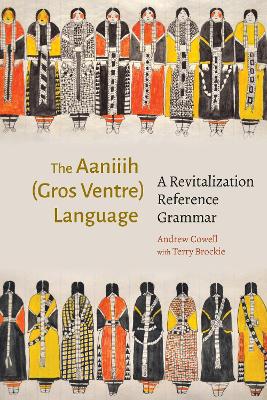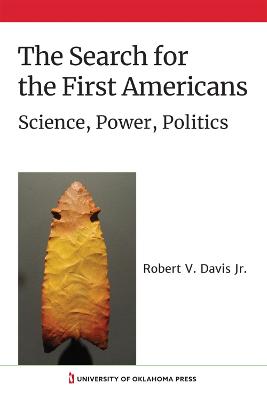Aaniiih (Gros Ventre) Language
 portes grátis
portes grátis
Aaniiih (Gros Ventre) Language
A Revitalization Reference Grammar
Cowell, Andrew
University of Nebraska Press
10/2024
628
Dura
Inglês
9781496238528
15 a 20 dias
Descrição não disponível.
List of Abbreviations and Symbols Used in This Grammar
List of Tables
Acknowledgements
Chapter One: Introduction
1.1 Situating the Aaniiih Language in Time and Space
1.2 The Aaniiih-Arapaho Languages
1.3 Classical and Twentieth-Century Aaniiih
1.4 Contemporary Aaniiih and Revitalization
1.5 Summary: What is a Revitalization Grammar?
Chapter Two: The Way Aaniiih Works
2.1 Agglutination (prefixes and suffixes) and Polysynthesis (multi-concept words)
2.2 Animacy of Nouns: NI vs NA
2.3. Different Verbs (Verb Stem Types) in Relation to the NI/NA Distinction
2.4 Different Verb "Orders" for Different Types of Information
2.5 Word Order and Other Means of Information Focusing
2.6 Person Hierarchy: Who's Most Important?
2.7 Male and Female Speech
Chapter Three: Phonology: The Sound System
3. 1 Phonemic Inventory and Features
3.1.1 Consonants
3.1.2 Vowels (Including Vowel Length, Vowel Harmony, Vowel Tone)
3.1.2.1 Vowel Length
3.1.2.2 Vowel Harmony
3.1.2.3 Vowel Tone
3.1.3 Phonotactics (Allowable Sound Combinations)
3.1.4 The Issue of Final /-n/ and /-w/.
3.2 Combining Morphemes (Meaning Units)
3.2.1 Underlying Stems
3.2.2 Glide Vowel
3.2.2.1 /V + V/ Sequences
3.2.3 Consonant Mutation
3.2.4 Vowel Quality Changes
3.2.5 Timing of Application of Vowel Harmony
3.2.6 Summary of Sound Changes Occurring Due to Morpheme Combinations
3.3 Stress, Syllable Structure, and Effects of Stress on Vowels
3.3.1 Syllable Structure
3.3.2 Stress
3.3.2.1 Lexical Stress on Stems
3.3.2.2 Grammatical Stress
3.3.3 Stress and Vowel Devoicing; Loss of Final -Vh/?
3.3.4 Stress and Vowel Quality
3.3.4.1 Stress and Vowel Quality (Long Vowels)
3.3.4.2 Stress and Phoneme Sequence /CyV/
3.3.4.3 Summary of Stress and Vowel Quality Changes
3.3.5 Stress and Vowel Syncope
3.3.6 More on Derivation, Inflection and Grammatical Stress
3.3.7 Deletion of Final Stress
3.3.8 Spreading of Stress and Syllable Merger
3.3.9 Prosodic Stress Beyond the Stem
3.4 Summary
Chapter Four: Noun Inflection and Derivation
4.1 Noun Classes: Animate and Inanimate
4.2 Noun Inflection
4.2.1 Plural
4.2.2 Noun Stress
4.2.3 Obviative
4.2.4 Locative
4.2.5 Possession
4.3 Verbal Nouns
4.4 Noun Derivation
4.4.1 Diminutives
4.4.2 'Young of...' Suffix
4.4.3 Vocatives
4.4.4 Deverbal Forms
4.4.5 Compounding and Noun Stem Formation
4.4.5.1 Compounding
4.4.5.2 Noun Stem Derivation (Creation)
4.5 Pronouns
4.5.1 Personal Pronouns
4.5.2 Indefinite Pronouns
4.5.3 Pseudo-verbal and other "Presentational" Forms
4.5.4 Interrogative Pronouns
4.5.5 Possessive Pronouns
4.6 Noun Phrases
4.6.1 Prenouns vs. Full Verbal Modifiers
4.6.2 Proclitics Occurring with Nouns
4.6.3 Adjectival and Number Verbs
4.6.4 Determiners
4.6.4.1 Definiteness and Identifiability
4.6.4.2 Emphatic Determiners
4.6.5 Noun Phrase Syntax
Chapter Five: Verbal Inflection
5.1 Proximate and Obviative System
5.2 Affirmative Order Verb Inflections
5.2.1 II Verb Inflections, Affirmative
5.2.2 AI Verb Inflections, Affirmative
5.2.3 TI Verb Inflections, Affirmative
5.2.4 TA Verbs Inflections, Affirmative
5.2.4.1 Direction-of-action Theme Markers
5.2.4.2 Person Hierarchy
5.2.4.3 TA Inflections
5.3 Non-Affirmative Order Verb Inflections
5.3.1 II Verb Inflections, Non-Affirmative
5.3.2 AI Verb Inflections, Non-Affirmative
5.3.3 TI Verb Inflections, Non-Affirmative
5.3.4 TA Verb Inflections, Non-Affirmative
5.3.5 Non-Affirmative Order Particles, Prefixes and Proclitics
5.4 Imperative Order Verb Inflections
5.4.1 Direct Imperative, AI
5.4.2 Direct Imperative, TI
5.4.3 Direct Imperative, TA
5.4.4 Indirect Imperative
5.4.5 Delayed/Future Imperative
5.4.6 Suggestive/Potential Imperative
5.4.7 Lexical Imperatives
5.4.8 Affirmative Order Imperative Forms
5.5 Conjunct Order Verb Inflections
5.5.1 Simple Conjunct Mode
5.5.2 Iterative Mode
5.5.2.1 'Whenever...'
5.5.2.2 Dubitative
5.5.2.3 'Whatever, However...'
5.5.2.4 'On...' 'In...' 'At...'
5.5.3 Subjunctive Mode
5.5.3.1 'When...'
5.5.3.2 'If...'
5.5.3.3 Hypothetical and Contrary-to-fact
5.5.3.4 Contrary-to-expectations
5.5.3.5 Epistemic marking
5.5.3.6 'Until...'
5.5.4 Dependent Participle
5.6 'To be...' in Aaniiih
5.6.1 Predicate Nominals
5.6.2 Predicate Adjectives
5.6.3 Predicate Locative
5.6.4 Predicate Possessives
5.6.5 'To be' Infinitives
Chapter Six: Verb Derivation
6.1 Primary Verb Derivation: Verb Finals
6.1.1 II and AI Primary Abstract Derivational Finals
6.1.2 TI and TA Primary Abstract Derivational Finals
6.1.3 Concrete Finals
6.1.3.1 Dependent Concrete Finals
6.1.3.2 Concrete Finals Derived from Independent Verb Stems
6.1.4 Verb Medials and Noun Incorporation
6.1.5 Medials as Verbal Classifiers
6.1.6 Open-Set Noun Incorporation
6.1.6.1 'Have a....'
6.1.6.2 'Be a... '
6.1.6.3 'Become a... '
6.1.6.4 'Have as a relation.... '
6.1.6.5 'Create or procure a...., ' 'Do work on or fix a.... '
6.2 Secondary Derivation
6.2.1 Valence Reducing
6.2.2 Valence Increasing
6.2.3 Valence Increasing, Two Arguments ? Three Arguments
6.2.4 Stem Class Shifting
6.2.5 Multiple Derivational Suffixes
6.3 Examples of New Verb Formation
Chapter Seven: Verbal Prefixes and Initials
7.1 Epistemic Prefixes Regarding Certainty of Information, and Evidentiality
7.2 Prefixes Indicating Relative Temporal Relationships
7.3 Prefixes Indicating Aspect and/or Temporal Frequency
7.4 Auxiliary-type (Deontic Modal) Prefixes
7.5 Prefixes Serving as Quantifiers and Intensifiers
7.6 Prefix Detachment
7.7 Manner, Direction and Location Prefixes/Verb Initials
7.8 Deictic Directional Prefixes
7.9 Reduplication
7.10 Complex Verb Initials and Prefixes
7.11 Noun and Verb Compounds vs. Initials: Restrictions on TI and TA Stems
Chapter Eight: Tense, Aspect and Modality
8.1 Affirmative Order Tense and Aspect
8.1.1 Initial Change
8.2 Non-Affirmative Order Tense and Aspect
8.3 Imperative Order Tense and Aspect
8.4 Conjunct Order Tense and Aspect
8.5 Sequential Action
8.6 Modality
8.6.1 Evidential Modality
8.6.2 Epistemic Modality
8.6.3 Deontic Modality
8.6.3.1 Commitments, Purposive Statements
8.6.3.2 Ability statements
Chapter Nine: Deverbalization Processes and Noun Formation
9.1 Agent Nominalizations
9.2 Deverbal Participles
9.2.1 AI Participles: Action and State Nominalizations
9.2.2 TI Participles: Instrument and Product Nominalizations
9.2.3 TA Participles: Action Nominalizations
9.3 Impersonal Verbs: Place and Time Nominalizations
9.3.1 Additional Place Nominalization Processes
Chapter Ten: Main Clause Syntax
10.1 Pragmatic Focus and the Sentence-Initial Position
10.1.1 Non-Actors in the Marked Position
10.1.2 Summary of Main Clause Syntax
10.2 Smaller-scale Syntactic Order in Aaniiih
10.3 Discontinuous Constituency
10.4 Di-Transitive Verbs and Secondary Objects
10.5 Comparatives and Superlatives
10.5.1 Comparison of Equality
10.5.2 Comparison of Inequality
10.5.3 Comparison Questions
10.5.4 Superlatives
Chapter Eleven: Subordinate and Complement Clauses
11.1 Relative Root Preverbs
11.1.1 Relative Roots as Initial Elements of Verbs Stems
11.1.2 Use of Relative Roots to Form 'to be' Expressions
11.2 More on Adverbial Clauses: "Prepositional" Phrases, Direction and Location
11.3 More on Complement Clauses: Complementizer
11.3.1 Complement Clauses: Translation of English 'to...' Infinitive Clauses
11.4 Pseudo-Cleft Expressions with Relative Roots
11.5 More on Relative Clauses
11.5.1 Relative Clauses and Adjectival Verbs
11.5.2 Relativization of Different Semantic Roles
Chapter Twelve: Particles and Discourse
12.1 Simple Particles
12.2 Complex Particles
12.2.1 Locative Particles
12.2.2 Adverbial Particles
12.2.2.1 Detached Forms
12.2.2.2 Independent Forms
12.2.2.3 Instrumental Adverbial Particle
12.2.2.4 Non-animate Causation and the Instrumental
12.2.2.5 Pseudo-Pronominal Preverbs
12.3 Exclamations
12.3.1 Admonitive Exclamations
12.4 Conversational Particles
12.5 Discourse-level Particles
12.6 The Grammar of Politeness
12.6.1 Questions
12.6.2 Commands
12.6.3 Requests and Recommendations
12.6.4 Statements
12.6.5 What Aaniiih Doesn't Do
Chapter Thirteen: Numbers, Times and Dates
13.1 Introduction: General Principles of Numbers in Aaniiih
13.2 Cardinal Numbers
13.3 Ordinal Numbers
13.4 Distributive and Collective Meanings
13.5 Types, Kinds
13.6 Money and Value Expressions; Weights, Lengths, Degrees, etc.
13.7 Time: Number of Days
13.8 Time: Specific Days, Months, Seasons
13.9 Time: Hours and Minutes
13.10 Time: Age
13.11 Time Duration (Lengths/Quantities of Time)
Chapter Fourteen: Special Language Practices
14.1 Placenames
14.2 Personal Names
14.3 Traditional Narratives
14.3.1 Opening and Closing Formulas
14.3.2 Main Clauses and Narrative Past Tense
14.3.3 Sequential ('and then...' 'and next...') Clauses
14.3.4 Subordinate Clauses
14.3.5 Reported Speech in Narration
14.3.6 Large-scale Discourse Structure
14.4 Songs
14.5 Prayer
14.6 Announcing and Honor Calling
14.7 Animal and Bird Calls, Sounds and Speech
14.8 Baby Talk
Chapter Fifteen: Modern/Twentieth-Century Aaniiih
15.1 Phonology
15.2 Nouns, Pronouns and Noun Phrases
15.2.1 Plurals
15.2.2 Locatives
15.2.3 Possession
15.2.4 Pronouns
15.2.5 Noun Phrases
15.3 Verbal Inflections
15.3.1 Affirmative Order
15.3.1.1 Details on TI (and AI.T) Affirmative
15.3.1.2 Details on TA Affirmative
15.3.2 Non-Affirmative Order
15.3.2.1 Details on AI Non-Affirmative
15.3.2.2 Details on TI Non-Affirmative
15.3.2.3 Details on TA Non-Affirmative
15.3.3 Imperative Order
15.3.4 Conjunct Order
15.3.4.1 Simple Conjunct
15.3.4.2 Dependent Participle
15.3.4.3 Iterative and Subjunctive
15.3.5 The General Process of Shift from 1S to 1P Inflections
15.4 Tense, Aspect and Modality
15.4.1 Tense and Aspect
15.4.2 Modality
15.5 Twentieth-Century Aaniiih from a Broader Aaniiih-Arapaho Perspective
15.6 Twentieth-Century Aaniiih from a Contact Perspective
15.7 Twentieth-Century Aaniiih and Internal Language Change
15.8 Conclusion
Chapter Sixteen: Contemporary Aaniiih and Revitalization
16.1 Phonology
16.1.1 Male and Female Consonants
16.1.2 The Role of Underlying Forms in Learning and Pedagogy
16.1.3 Orthography
16.2 Nouns, Pronouns and Noun Phrases
16.2.1 Noun Plurals
16.2.2 Possession
16.2.3 Noun Phrase
16.3 Verb Inflections
16.3.1 AI and TI Inflections
16.3.2 TA Inflections
16.3.3 Imperatives
16.3.4 Iterative and Subjunctive Inflections
16.3.5 Dependent Participles
16.4 Tense, Aspect and Modality
16.5 Other Components of the Grammar
16.6 Special Speech Forms
16.7 New Word Formation
16.8 Summary of Key Issues and Current Plans in Revitalization Aaniiih
Chapter Seventeen: A Classical Aaniiih Text
Appendices
Appendix One: Aaniiih Historical Phonology, from PA to Aaniiih
Appendix Two: From PA to Classical Aaniiih: Basic Inflections
Appendix Three: Umfreville's 1786 Documentation of Aaniiih
Appendix Four: Prince Maximillian von Wied's 1833-34 documentation of Aaniiih
Appendix Five: Hayden's 1855 Documentation of Aaniiih
Appendix Six: Unexpected NA Nouns
Appendix Seven: Revitalization Aaniiih Verb Paradigms
Bibliography and Sources
Index
List of Tables
Acknowledgements
Chapter One: Introduction
1.1 Situating the Aaniiih Language in Time and Space
1.2 The Aaniiih-Arapaho Languages
1.3 Classical and Twentieth-Century Aaniiih
1.4 Contemporary Aaniiih and Revitalization
1.5 Summary: What is a Revitalization Grammar?
Chapter Two: The Way Aaniiih Works
2.1 Agglutination (prefixes and suffixes) and Polysynthesis (multi-concept words)
2.2 Animacy of Nouns: NI vs NA
2.3. Different Verbs (Verb Stem Types) in Relation to the NI/NA Distinction
2.4 Different Verb "Orders" for Different Types of Information
2.5 Word Order and Other Means of Information Focusing
2.6 Person Hierarchy: Who's Most Important?
2.7 Male and Female Speech
Chapter Three: Phonology: The Sound System
3. 1 Phonemic Inventory and Features
3.1.1 Consonants
3.1.2 Vowels (Including Vowel Length, Vowel Harmony, Vowel Tone)
3.1.2.1 Vowel Length
3.1.2.2 Vowel Harmony
3.1.2.3 Vowel Tone
3.1.3 Phonotactics (Allowable Sound Combinations)
3.1.4 The Issue of Final /-n/ and /-w/.
3.2 Combining Morphemes (Meaning Units)
3.2.1 Underlying Stems
3.2.2 Glide Vowel
3.2.2.1 /V + V/ Sequences
3.2.3 Consonant Mutation
3.2.4 Vowel Quality Changes
3.2.5 Timing of Application of Vowel Harmony
3.2.6 Summary of Sound Changes Occurring Due to Morpheme Combinations
3.3 Stress, Syllable Structure, and Effects of Stress on Vowels
3.3.1 Syllable Structure
3.3.2 Stress
3.3.2.1 Lexical Stress on Stems
3.3.2.2 Grammatical Stress
3.3.3 Stress and Vowel Devoicing; Loss of Final -Vh/?
3.3.4 Stress and Vowel Quality
3.3.4.1 Stress and Vowel Quality (Long Vowels)
3.3.4.2 Stress and Phoneme Sequence /CyV/
3.3.4.3 Summary of Stress and Vowel Quality Changes
3.3.5 Stress and Vowel Syncope
3.3.6 More on Derivation, Inflection and Grammatical Stress
3.3.7 Deletion of Final Stress
3.3.8 Spreading of Stress and Syllable Merger
3.3.9 Prosodic Stress Beyond the Stem
3.4 Summary
Chapter Four: Noun Inflection and Derivation
4.1 Noun Classes: Animate and Inanimate
4.2 Noun Inflection
4.2.1 Plural
4.2.2 Noun Stress
4.2.3 Obviative
4.2.4 Locative
4.2.5 Possession
4.3 Verbal Nouns
4.4 Noun Derivation
4.4.1 Diminutives
4.4.2 'Young of...' Suffix
4.4.3 Vocatives
4.4.4 Deverbal Forms
4.4.5 Compounding and Noun Stem Formation
4.4.5.1 Compounding
4.4.5.2 Noun Stem Derivation (Creation)
4.5 Pronouns
4.5.1 Personal Pronouns
4.5.2 Indefinite Pronouns
4.5.3 Pseudo-verbal and other "Presentational" Forms
4.5.4 Interrogative Pronouns
4.5.5 Possessive Pronouns
4.6 Noun Phrases
4.6.1 Prenouns vs. Full Verbal Modifiers
4.6.2 Proclitics Occurring with Nouns
4.6.3 Adjectival and Number Verbs
4.6.4 Determiners
4.6.4.1 Definiteness and Identifiability
4.6.4.2 Emphatic Determiners
4.6.5 Noun Phrase Syntax
Chapter Five: Verbal Inflection
5.1 Proximate and Obviative System
5.2 Affirmative Order Verb Inflections
5.2.1 II Verb Inflections, Affirmative
5.2.2 AI Verb Inflections, Affirmative
5.2.3 TI Verb Inflections, Affirmative
5.2.4 TA Verbs Inflections, Affirmative
5.2.4.1 Direction-of-action Theme Markers
5.2.4.2 Person Hierarchy
5.2.4.3 TA Inflections
5.3 Non-Affirmative Order Verb Inflections
5.3.1 II Verb Inflections, Non-Affirmative
5.3.2 AI Verb Inflections, Non-Affirmative
5.3.3 TI Verb Inflections, Non-Affirmative
5.3.4 TA Verb Inflections, Non-Affirmative
5.3.5 Non-Affirmative Order Particles, Prefixes and Proclitics
5.4 Imperative Order Verb Inflections
5.4.1 Direct Imperative, AI
5.4.2 Direct Imperative, TI
5.4.3 Direct Imperative, TA
5.4.4 Indirect Imperative
5.4.5 Delayed/Future Imperative
5.4.6 Suggestive/Potential Imperative
5.4.7 Lexical Imperatives
5.4.8 Affirmative Order Imperative Forms
5.5 Conjunct Order Verb Inflections
5.5.1 Simple Conjunct Mode
5.5.2 Iterative Mode
5.5.2.1 'Whenever...'
5.5.2.2 Dubitative
5.5.2.3 'Whatever, However...'
5.5.2.4 'On...' 'In...' 'At...'
5.5.3 Subjunctive Mode
5.5.3.1 'When...'
5.5.3.2 'If...'
5.5.3.3 Hypothetical and Contrary-to-fact
5.5.3.4 Contrary-to-expectations
5.5.3.5 Epistemic marking
5.5.3.6 'Until...'
5.5.4 Dependent Participle
5.6 'To be...' in Aaniiih
5.6.1 Predicate Nominals
5.6.2 Predicate Adjectives
5.6.3 Predicate Locative
5.6.4 Predicate Possessives
5.6.5 'To be' Infinitives
Chapter Six: Verb Derivation
6.1 Primary Verb Derivation: Verb Finals
6.1.1 II and AI Primary Abstract Derivational Finals
6.1.2 TI and TA Primary Abstract Derivational Finals
6.1.3 Concrete Finals
6.1.3.1 Dependent Concrete Finals
6.1.3.2 Concrete Finals Derived from Independent Verb Stems
6.1.4 Verb Medials and Noun Incorporation
6.1.5 Medials as Verbal Classifiers
6.1.6 Open-Set Noun Incorporation
6.1.6.1 'Have a....'
6.1.6.2 'Be a... '
6.1.6.3 'Become a... '
6.1.6.4 'Have as a relation.... '
6.1.6.5 'Create or procure a...., ' 'Do work on or fix a.... '
6.2 Secondary Derivation
6.2.1 Valence Reducing
6.2.2 Valence Increasing
6.2.3 Valence Increasing, Two Arguments ? Three Arguments
6.2.4 Stem Class Shifting
6.2.5 Multiple Derivational Suffixes
6.3 Examples of New Verb Formation
Chapter Seven: Verbal Prefixes and Initials
7.1 Epistemic Prefixes Regarding Certainty of Information, and Evidentiality
7.2 Prefixes Indicating Relative Temporal Relationships
7.3 Prefixes Indicating Aspect and/or Temporal Frequency
7.4 Auxiliary-type (Deontic Modal) Prefixes
7.5 Prefixes Serving as Quantifiers and Intensifiers
7.6 Prefix Detachment
7.7 Manner, Direction and Location Prefixes/Verb Initials
7.8 Deictic Directional Prefixes
7.9 Reduplication
7.10 Complex Verb Initials and Prefixes
7.11 Noun and Verb Compounds vs. Initials: Restrictions on TI and TA Stems
Chapter Eight: Tense, Aspect and Modality
8.1 Affirmative Order Tense and Aspect
8.1.1 Initial Change
8.2 Non-Affirmative Order Tense and Aspect
8.3 Imperative Order Tense and Aspect
8.4 Conjunct Order Tense and Aspect
8.5 Sequential Action
8.6 Modality
8.6.1 Evidential Modality
8.6.2 Epistemic Modality
8.6.3 Deontic Modality
8.6.3.1 Commitments, Purposive Statements
8.6.3.2 Ability statements
Chapter Nine: Deverbalization Processes and Noun Formation
9.1 Agent Nominalizations
9.2 Deverbal Participles
9.2.1 AI Participles: Action and State Nominalizations
9.2.2 TI Participles: Instrument and Product Nominalizations
9.2.3 TA Participles: Action Nominalizations
9.3 Impersonal Verbs: Place and Time Nominalizations
9.3.1 Additional Place Nominalization Processes
Chapter Ten: Main Clause Syntax
10.1 Pragmatic Focus and the Sentence-Initial Position
10.1.1 Non-Actors in the Marked Position
10.1.2 Summary of Main Clause Syntax
10.2 Smaller-scale Syntactic Order in Aaniiih
10.3 Discontinuous Constituency
10.4 Di-Transitive Verbs and Secondary Objects
10.5 Comparatives and Superlatives
10.5.1 Comparison of Equality
10.5.2 Comparison of Inequality
10.5.3 Comparison Questions
10.5.4 Superlatives
Chapter Eleven: Subordinate and Complement Clauses
11.1 Relative Root Preverbs
11.1.1 Relative Roots as Initial Elements of Verbs Stems
11.1.2 Use of Relative Roots to Form 'to be' Expressions
11.2 More on Adverbial Clauses: "Prepositional" Phrases, Direction and Location
11.3 More on Complement Clauses: Complementizer
11.3.1 Complement Clauses: Translation of English 'to...' Infinitive Clauses
11.4 Pseudo-Cleft Expressions with Relative Roots
11.5 More on Relative Clauses
11.5.1 Relative Clauses and Adjectival Verbs
11.5.2 Relativization of Different Semantic Roles
Chapter Twelve: Particles and Discourse
12.1 Simple Particles
12.2 Complex Particles
12.2.1 Locative Particles
12.2.2 Adverbial Particles
12.2.2.1 Detached Forms
12.2.2.2 Independent Forms
12.2.2.3 Instrumental Adverbial Particle
12.2.2.4 Non-animate Causation and the Instrumental
12.2.2.5 Pseudo-Pronominal Preverbs
12.3 Exclamations
12.3.1 Admonitive Exclamations
12.4 Conversational Particles
12.5 Discourse-level Particles
12.6 The Grammar of Politeness
12.6.1 Questions
12.6.2 Commands
12.6.3 Requests and Recommendations
12.6.4 Statements
12.6.5 What Aaniiih Doesn't Do
Chapter Thirteen: Numbers, Times and Dates
13.1 Introduction: General Principles of Numbers in Aaniiih
13.2 Cardinal Numbers
13.3 Ordinal Numbers
13.4 Distributive and Collective Meanings
13.5 Types, Kinds
13.6 Money and Value Expressions; Weights, Lengths, Degrees, etc.
13.7 Time: Number of Days
13.8 Time: Specific Days, Months, Seasons
13.9 Time: Hours and Minutes
13.10 Time: Age
13.11 Time Duration (Lengths/Quantities of Time)
Chapter Fourteen: Special Language Practices
14.1 Placenames
14.2 Personal Names
14.3 Traditional Narratives
14.3.1 Opening and Closing Formulas
14.3.2 Main Clauses and Narrative Past Tense
14.3.3 Sequential ('and then...' 'and next...') Clauses
14.3.4 Subordinate Clauses
14.3.5 Reported Speech in Narration
14.3.6 Large-scale Discourse Structure
14.4 Songs
14.5 Prayer
14.6 Announcing and Honor Calling
14.7 Animal and Bird Calls, Sounds and Speech
14.8 Baby Talk
Chapter Fifteen: Modern/Twentieth-Century Aaniiih
15.1 Phonology
15.2 Nouns, Pronouns and Noun Phrases
15.2.1 Plurals
15.2.2 Locatives
15.2.3 Possession
15.2.4 Pronouns
15.2.5 Noun Phrases
15.3 Verbal Inflections
15.3.1 Affirmative Order
15.3.1.1 Details on TI (and AI.T) Affirmative
15.3.1.2 Details on TA Affirmative
15.3.2 Non-Affirmative Order
15.3.2.1 Details on AI Non-Affirmative
15.3.2.2 Details on TI Non-Affirmative
15.3.2.3 Details on TA Non-Affirmative
15.3.3 Imperative Order
15.3.4 Conjunct Order
15.3.4.1 Simple Conjunct
15.3.4.2 Dependent Participle
15.3.4.3 Iterative and Subjunctive
15.3.5 The General Process of Shift from 1S to 1P Inflections
15.4 Tense, Aspect and Modality
15.4.1 Tense and Aspect
15.4.2 Modality
15.5 Twentieth-Century Aaniiih from a Broader Aaniiih-Arapaho Perspective
15.6 Twentieth-Century Aaniiih from a Contact Perspective
15.7 Twentieth-Century Aaniiih and Internal Language Change
15.8 Conclusion
Chapter Sixteen: Contemporary Aaniiih and Revitalization
16.1 Phonology
16.1.1 Male and Female Consonants
16.1.2 The Role of Underlying Forms in Learning and Pedagogy
16.1.3 Orthography
16.2 Nouns, Pronouns and Noun Phrases
16.2.1 Noun Plurals
16.2.2 Possession
16.2.3 Noun Phrase
16.3 Verb Inflections
16.3.1 AI and TI Inflections
16.3.2 TA Inflections
16.3.3 Imperatives
16.3.4 Iterative and Subjunctive Inflections
16.3.5 Dependent Participles
16.4 Tense, Aspect and Modality
16.5 Other Components of the Grammar
16.6 Special Speech Forms
16.7 New Word Formation
16.8 Summary of Key Issues and Current Plans in Revitalization Aaniiih
Chapter Seventeen: A Classical Aaniiih Text
Appendices
Appendix One: Aaniiih Historical Phonology, from PA to Aaniiih
Appendix Two: From PA to Classical Aaniiih: Basic Inflections
Appendix Three: Umfreville's 1786 Documentation of Aaniiih
Appendix Four: Prince Maximillian von Wied's 1833-34 documentation of Aaniiih
Appendix Five: Hayden's 1855 Documentation of Aaniiih
Appendix Six: Unexpected NA Nouns
Appendix Seven: Revitalization Aaniiih Verb Paradigms
Bibliography and Sources
Index
Este título pertence ao(s) assunto(s) indicados(s). Para ver outros títulos clique no assunto desejado.
Aaniiih language; Gros Ventre Language; Gros Ventre; Algonquian language family; Algonquian languages; Arapaho language; Alberta Canada Native language; Saskatchewan Canada Native language; northern Montana Native language; Canadian US border Native language; Fort Belknap Reservation; Great Plains Indigenous Languages; Native American Languages; Native American Studies; Native American Linguistics; reference grammar; Native American language reference; Language Revitalization Studies; Ethnography of Language; revitalization reference grammar; language revitalization; Indigenous Studies; Native American History; Ethnohistory; Ethnic Studies
List of Abbreviations and Symbols Used in This Grammar
List of Tables
Acknowledgements
Chapter One: Introduction
1.1 Situating the Aaniiih Language in Time and Space
1.2 The Aaniiih-Arapaho Languages
1.3 Classical and Twentieth-Century Aaniiih
1.4 Contemporary Aaniiih and Revitalization
1.5 Summary: What is a Revitalization Grammar?
Chapter Two: The Way Aaniiih Works
2.1 Agglutination (prefixes and suffixes) and Polysynthesis (multi-concept words)
2.2 Animacy of Nouns: NI vs NA
2.3. Different Verbs (Verb Stem Types) in Relation to the NI/NA Distinction
2.4 Different Verb "Orders" for Different Types of Information
2.5 Word Order and Other Means of Information Focusing
2.6 Person Hierarchy: Who's Most Important?
2.7 Male and Female Speech
Chapter Three: Phonology: The Sound System
3. 1 Phonemic Inventory and Features
3.1.1 Consonants
3.1.2 Vowels (Including Vowel Length, Vowel Harmony, Vowel Tone)
3.1.2.1 Vowel Length
3.1.2.2 Vowel Harmony
3.1.2.3 Vowel Tone
3.1.3 Phonotactics (Allowable Sound Combinations)
3.1.4 The Issue of Final /-n/ and /-w/.
3.2 Combining Morphemes (Meaning Units)
3.2.1 Underlying Stems
3.2.2 Glide Vowel
3.2.2.1 /V + V/ Sequences
3.2.3 Consonant Mutation
3.2.4 Vowel Quality Changes
3.2.5 Timing of Application of Vowel Harmony
3.2.6 Summary of Sound Changes Occurring Due to Morpheme Combinations
3.3 Stress, Syllable Structure, and Effects of Stress on Vowels
3.3.1 Syllable Structure
3.3.2 Stress
3.3.2.1 Lexical Stress on Stems
3.3.2.2 Grammatical Stress
3.3.3 Stress and Vowel Devoicing; Loss of Final -Vh/?
3.3.4 Stress and Vowel Quality
3.3.4.1 Stress and Vowel Quality (Long Vowels)
3.3.4.2 Stress and Phoneme Sequence /CyV/
3.3.4.3 Summary of Stress and Vowel Quality Changes
3.3.5 Stress and Vowel Syncope
3.3.6 More on Derivation, Inflection and Grammatical Stress
3.3.7 Deletion of Final Stress
3.3.8 Spreading of Stress and Syllable Merger
3.3.9 Prosodic Stress Beyond the Stem
3.4 Summary
Chapter Four: Noun Inflection and Derivation
4.1 Noun Classes: Animate and Inanimate
4.2 Noun Inflection
4.2.1 Plural
4.2.2 Noun Stress
4.2.3 Obviative
4.2.4 Locative
4.2.5 Possession
4.3 Verbal Nouns
4.4 Noun Derivation
4.4.1 Diminutives
4.4.2 'Young of...' Suffix
4.4.3 Vocatives
4.4.4 Deverbal Forms
4.4.5 Compounding and Noun Stem Formation
4.4.5.1 Compounding
4.4.5.2 Noun Stem Derivation (Creation)
4.5 Pronouns
4.5.1 Personal Pronouns
4.5.2 Indefinite Pronouns
4.5.3 Pseudo-verbal and other "Presentational" Forms
4.5.4 Interrogative Pronouns
4.5.5 Possessive Pronouns
4.6 Noun Phrases
4.6.1 Prenouns vs. Full Verbal Modifiers
4.6.2 Proclitics Occurring with Nouns
4.6.3 Adjectival and Number Verbs
4.6.4 Determiners
4.6.4.1 Definiteness and Identifiability
4.6.4.2 Emphatic Determiners
4.6.5 Noun Phrase Syntax
Chapter Five: Verbal Inflection
5.1 Proximate and Obviative System
5.2 Affirmative Order Verb Inflections
5.2.1 II Verb Inflections, Affirmative
5.2.2 AI Verb Inflections, Affirmative
5.2.3 TI Verb Inflections, Affirmative
5.2.4 TA Verbs Inflections, Affirmative
5.2.4.1 Direction-of-action Theme Markers
5.2.4.2 Person Hierarchy
5.2.4.3 TA Inflections
5.3 Non-Affirmative Order Verb Inflections
5.3.1 II Verb Inflections, Non-Affirmative
5.3.2 AI Verb Inflections, Non-Affirmative
5.3.3 TI Verb Inflections, Non-Affirmative
5.3.4 TA Verb Inflections, Non-Affirmative
5.3.5 Non-Affirmative Order Particles, Prefixes and Proclitics
5.4 Imperative Order Verb Inflections
5.4.1 Direct Imperative, AI
5.4.2 Direct Imperative, TI
5.4.3 Direct Imperative, TA
5.4.4 Indirect Imperative
5.4.5 Delayed/Future Imperative
5.4.6 Suggestive/Potential Imperative
5.4.7 Lexical Imperatives
5.4.8 Affirmative Order Imperative Forms
5.5 Conjunct Order Verb Inflections
5.5.1 Simple Conjunct Mode
5.5.2 Iterative Mode
5.5.2.1 'Whenever...'
5.5.2.2 Dubitative
5.5.2.3 'Whatever, However...'
5.5.2.4 'On...' 'In...' 'At...'
5.5.3 Subjunctive Mode
5.5.3.1 'When...'
5.5.3.2 'If...'
5.5.3.3 Hypothetical and Contrary-to-fact
5.5.3.4 Contrary-to-expectations
5.5.3.5 Epistemic marking
5.5.3.6 'Until...'
5.5.4 Dependent Participle
5.6 'To be...' in Aaniiih
5.6.1 Predicate Nominals
5.6.2 Predicate Adjectives
5.6.3 Predicate Locative
5.6.4 Predicate Possessives
5.6.5 'To be' Infinitives
Chapter Six: Verb Derivation
6.1 Primary Verb Derivation: Verb Finals
6.1.1 II and AI Primary Abstract Derivational Finals
6.1.2 TI and TA Primary Abstract Derivational Finals
6.1.3 Concrete Finals
6.1.3.1 Dependent Concrete Finals
6.1.3.2 Concrete Finals Derived from Independent Verb Stems
6.1.4 Verb Medials and Noun Incorporation
6.1.5 Medials as Verbal Classifiers
6.1.6 Open-Set Noun Incorporation
6.1.6.1 'Have a....'
6.1.6.2 'Be a... '
6.1.6.3 'Become a... '
6.1.6.4 'Have as a relation.... '
6.1.6.5 'Create or procure a...., ' 'Do work on or fix a.... '
6.2 Secondary Derivation
6.2.1 Valence Reducing
6.2.2 Valence Increasing
6.2.3 Valence Increasing, Two Arguments ? Three Arguments
6.2.4 Stem Class Shifting
6.2.5 Multiple Derivational Suffixes
6.3 Examples of New Verb Formation
Chapter Seven: Verbal Prefixes and Initials
7.1 Epistemic Prefixes Regarding Certainty of Information, and Evidentiality
7.2 Prefixes Indicating Relative Temporal Relationships
7.3 Prefixes Indicating Aspect and/or Temporal Frequency
7.4 Auxiliary-type (Deontic Modal) Prefixes
7.5 Prefixes Serving as Quantifiers and Intensifiers
7.6 Prefix Detachment
7.7 Manner, Direction and Location Prefixes/Verb Initials
7.8 Deictic Directional Prefixes
7.9 Reduplication
7.10 Complex Verb Initials and Prefixes
7.11 Noun and Verb Compounds vs. Initials: Restrictions on TI and TA Stems
Chapter Eight: Tense, Aspect and Modality
8.1 Affirmative Order Tense and Aspect
8.1.1 Initial Change
8.2 Non-Affirmative Order Tense and Aspect
8.3 Imperative Order Tense and Aspect
8.4 Conjunct Order Tense and Aspect
8.5 Sequential Action
8.6 Modality
8.6.1 Evidential Modality
8.6.2 Epistemic Modality
8.6.3 Deontic Modality
8.6.3.1 Commitments, Purposive Statements
8.6.3.2 Ability statements
Chapter Nine: Deverbalization Processes and Noun Formation
9.1 Agent Nominalizations
9.2 Deverbal Participles
9.2.1 AI Participles: Action and State Nominalizations
9.2.2 TI Participles: Instrument and Product Nominalizations
9.2.3 TA Participles: Action Nominalizations
9.3 Impersonal Verbs: Place and Time Nominalizations
9.3.1 Additional Place Nominalization Processes
Chapter Ten: Main Clause Syntax
10.1 Pragmatic Focus and the Sentence-Initial Position
10.1.1 Non-Actors in the Marked Position
10.1.2 Summary of Main Clause Syntax
10.2 Smaller-scale Syntactic Order in Aaniiih
10.3 Discontinuous Constituency
10.4 Di-Transitive Verbs and Secondary Objects
10.5 Comparatives and Superlatives
10.5.1 Comparison of Equality
10.5.2 Comparison of Inequality
10.5.3 Comparison Questions
10.5.4 Superlatives
Chapter Eleven: Subordinate and Complement Clauses
11.1 Relative Root Preverbs
11.1.1 Relative Roots as Initial Elements of Verbs Stems
11.1.2 Use of Relative Roots to Form 'to be' Expressions
11.2 More on Adverbial Clauses: "Prepositional" Phrases, Direction and Location
11.3 More on Complement Clauses: Complementizer
11.3.1 Complement Clauses: Translation of English 'to...' Infinitive Clauses
11.4 Pseudo-Cleft Expressions with Relative Roots
11.5 More on Relative Clauses
11.5.1 Relative Clauses and Adjectival Verbs
11.5.2 Relativization of Different Semantic Roles
Chapter Twelve: Particles and Discourse
12.1 Simple Particles
12.2 Complex Particles
12.2.1 Locative Particles
12.2.2 Adverbial Particles
12.2.2.1 Detached Forms
12.2.2.2 Independent Forms
12.2.2.3 Instrumental Adverbial Particle
12.2.2.4 Non-animate Causation and the Instrumental
12.2.2.5 Pseudo-Pronominal Preverbs
12.3 Exclamations
12.3.1 Admonitive Exclamations
12.4 Conversational Particles
12.5 Discourse-level Particles
12.6 The Grammar of Politeness
12.6.1 Questions
12.6.2 Commands
12.6.3 Requests and Recommendations
12.6.4 Statements
12.6.5 What Aaniiih Doesn't Do
Chapter Thirteen: Numbers, Times and Dates
13.1 Introduction: General Principles of Numbers in Aaniiih
13.2 Cardinal Numbers
13.3 Ordinal Numbers
13.4 Distributive and Collective Meanings
13.5 Types, Kinds
13.6 Money and Value Expressions; Weights, Lengths, Degrees, etc.
13.7 Time: Number of Days
13.8 Time: Specific Days, Months, Seasons
13.9 Time: Hours and Minutes
13.10 Time: Age
13.11 Time Duration (Lengths/Quantities of Time)
Chapter Fourteen: Special Language Practices
14.1 Placenames
14.2 Personal Names
14.3 Traditional Narratives
14.3.1 Opening and Closing Formulas
14.3.2 Main Clauses and Narrative Past Tense
14.3.3 Sequential ('and then...' 'and next...') Clauses
14.3.4 Subordinate Clauses
14.3.5 Reported Speech in Narration
14.3.6 Large-scale Discourse Structure
14.4 Songs
14.5 Prayer
14.6 Announcing and Honor Calling
14.7 Animal and Bird Calls, Sounds and Speech
14.8 Baby Talk
Chapter Fifteen: Modern/Twentieth-Century Aaniiih
15.1 Phonology
15.2 Nouns, Pronouns and Noun Phrases
15.2.1 Plurals
15.2.2 Locatives
15.2.3 Possession
15.2.4 Pronouns
15.2.5 Noun Phrases
15.3 Verbal Inflections
15.3.1 Affirmative Order
15.3.1.1 Details on TI (and AI.T) Affirmative
15.3.1.2 Details on TA Affirmative
15.3.2 Non-Affirmative Order
15.3.2.1 Details on AI Non-Affirmative
15.3.2.2 Details on TI Non-Affirmative
15.3.2.3 Details on TA Non-Affirmative
15.3.3 Imperative Order
15.3.4 Conjunct Order
15.3.4.1 Simple Conjunct
15.3.4.2 Dependent Participle
15.3.4.3 Iterative and Subjunctive
15.3.5 The General Process of Shift from 1S to 1P Inflections
15.4 Tense, Aspect and Modality
15.4.1 Tense and Aspect
15.4.2 Modality
15.5 Twentieth-Century Aaniiih from a Broader Aaniiih-Arapaho Perspective
15.6 Twentieth-Century Aaniiih from a Contact Perspective
15.7 Twentieth-Century Aaniiih and Internal Language Change
15.8 Conclusion
Chapter Sixteen: Contemporary Aaniiih and Revitalization
16.1 Phonology
16.1.1 Male and Female Consonants
16.1.2 The Role of Underlying Forms in Learning and Pedagogy
16.1.3 Orthography
16.2 Nouns, Pronouns and Noun Phrases
16.2.1 Noun Plurals
16.2.2 Possession
16.2.3 Noun Phrase
16.3 Verb Inflections
16.3.1 AI and TI Inflections
16.3.2 TA Inflections
16.3.3 Imperatives
16.3.4 Iterative and Subjunctive Inflections
16.3.5 Dependent Participles
16.4 Tense, Aspect and Modality
16.5 Other Components of the Grammar
16.6 Special Speech Forms
16.7 New Word Formation
16.8 Summary of Key Issues and Current Plans in Revitalization Aaniiih
Chapter Seventeen: A Classical Aaniiih Text
Appendices
Appendix One: Aaniiih Historical Phonology, from PA to Aaniiih
Appendix Two: From PA to Classical Aaniiih: Basic Inflections
Appendix Three: Umfreville's 1786 Documentation of Aaniiih
Appendix Four: Prince Maximillian von Wied's 1833-34 documentation of Aaniiih
Appendix Five: Hayden's 1855 Documentation of Aaniiih
Appendix Six: Unexpected NA Nouns
Appendix Seven: Revitalization Aaniiih Verb Paradigms
Bibliography and Sources
Index
List of Tables
Acknowledgements
Chapter One: Introduction
1.1 Situating the Aaniiih Language in Time and Space
1.2 The Aaniiih-Arapaho Languages
1.3 Classical and Twentieth-Century Aaniiih
1.4 Contemporary Aaniiih and Revitalization
1.5 Summary: What is a Revitalization Grammar?
Chapter Two: The Way Aaniiih Works
2.1 Agglutination (prefixes and suffixes) and Polysynthesis (multi-concept words)
2.2 Animacy of Nouns: NI vs NA
2.3. Different Verbs (Verb Stem Types) in Relation to the NI/NA Distinction
2.4 Different Verb "Orders" for Different Types of Information
2.5 Word Order and Other Means of Information Focusing
2.6 Person Hierarchy: Who's Most Important?
2.7 Male and Female Speech
Chapter Three: Phonology: The Sound System
3. 1 Phonemic Inventory and Features
3.1.1 Consonants
3.1.2 Vowels (Including Vowel Length, Vowel Harmony, Vowel Tone)
3.1.2.1 Vowel Length
3.1.2.2 Vowel Harmony
3.1.2.3 Vowel Tone
3.1.3 Phonotactics (Allowable Sound Combinations)
3.1.4 The Issue of Final /-n/ and /-w/.
3.2 Combining Morphemes (Meaning Units)
3.2.1 Underlying Stems
3.2.2 Glide Vowel
3.2.2.1 /V + V/ Sequences
3.2.3 Consonant Mutation
3.2.4 Vowel Quality Changes
3.2.5 Timing of Application of Vowel Harmony
3.2.6 Summary of Sound Changes Occurring Due to Morpheme Combinations
3.3 Stress, Syllable Structure, and Effects of Stress on Vowels
3.3.1 Syllable Structure
3.3.2 Stress
3.3.2.1 Lexical Stress on Stems
3.3.2.2 Grammatical Stress
3.3.3 Stress and Vowel Devoicing; Loss of Final -Vh/?
3.3.4 Stress and Vowel Quality
3.3.4.1 Stress and Vowel Quality (Long Vowels)
3.3.4.2 Stress and Phoneme Sequence /CyV/
3.3.4.3 Summary of Stress and Vowel Quality Changes
3.3.5 Stress and Vowel Syncope
3.3.6 More on Derivation, Inflection and Grammatical Stress
3.3.7 Deletion of Final Stress
3.3.8 Spreading of Stress and Syllable Merger
3.3.9 Prosodic Stress Beyond the Stem
3.4 Summary
Chapter Four: Noun Inflection and Derivation
4.1 Noun Classes: Animate and Inanimate
4.2 Noun Inflection
4.2.1 Plural
4.2.2 Noun Stress
4.2.3 Obviative
4.2.4 Locative
4.2.5 Possession
4.3 Verbal Nouns
4.4 Noun Derivation
4.4.1 Diminutives
4.4.2 'Young of...' Suffix
4.4.3 Vocatives
4.4.4 Deverbal Forms
4.4.5 Compounding and Noun Stem Formation
4.4.5.1 Compounding
4.4.5.2 Noun Stem Derivation (Creation)
4.5 Pronouns
4.5.1 Personal Pronouns
4.5.2 Indefinite Pronouns
4.5.3 Pseudo-verbal and other "Presentational" Forms
4.5.4 Interrogative Pronouns
4.5.5 Possessive Pronouns
4.6 Noun Phrases
4.6.1 Prenouns vs. Full Verbal Modifiers
4.6.2 Proclitics Occurring with Nouns
4.6.3 Adjectival and Number Verbs
4.6.4 Determiners
4.6.4.1 Definiteness and Identifiability
4.6.4.2 Emphatic Determiners
4.6.5 Noun Phrase Syntax
Chapter Five: Verbal Inflection
5.1 Proximate and Obviative System
5.2 Affirmative Order Verb Inflections
5.2.1 II Verb Inflections, Affirmative
5.2.2 AI Verb Inflections, Affirmative
5.2.3 TI Verb Inflections, Affirmative
5.2.4 TA Verbs Inflections, Affirmative
5.2.4.1 Direction-of-action Theme Markers
5.2.4.2 Person Hierarchy
5.2.4.3 TA Inflections
5.3 Non-Affirmative Order Verb Inflections
5.3.1 II Verb Inflections, Non-Affirmative
5.3.2 AI Verb Inflections, Non-Affirmative
5.3.3 TI Verb Inflections, Non-Affirmative
5.3.4 TA Verb Inflections, Non-Affirmative
5.3.5 Non-Affirmative Order Particles, Prefixes and Proclitics
5.4 Imperative Order Verb Inflections
5.4.1 Direct Imperative, AI
5.4.2 Direct Imperative, TI
5.4.3 Direct Imperative, TA
5.4.4 Indirect Imperative
5.4.5 Delayed/Future Imperative
5.4.6 Suggestive/Potential Imperative
5.4.7 Lexical Imperatives
5.4.8 Affirmative Order Imperative Forms
5.5 Conjunct Order Verb Inflections
5.5.1 Simple Conjunct Mode
5.5.2 Iterative Mode
5.5.2.1 'Whenever...'
5.5.2.2 Dubitative
5.5.2.3 'Whatever, However...'
5.5.2.4 'On...' 'In...' 'At...'
5.5.3 Subjunctive Mode
5.5.3.1 'When...'
5.5.3.2 'If...'
5.5.3.3 Hypothetical and Contrary-to-fact
5.5.3.4 Contrary-to-expectations
5.5.3.5 Epistemic marking
5.5.3.6 'Until...'
5.5.4 Dependent Participle
5.6 'To be...' in Aaniiih
5.6.1 Predicate Nominals
5.6.2 Predicate Adjectives
5.6.3 Predicate Locative
5.6.4 Predicate Possessives
5.6.5 'To be' Infinitives
Chapter Six: Verb Derivation
6.1 Primary Verb Derivation: Verb Finals
6.1.1 II and AI Primary Abstract Derivational Finals
6.1.2 TI and TA Primary Abstract Derivational Finals
6.1.3 Concrete Finals
6.1.3.1 Dependent Concrete Finals
6.1.3.2 Concrete Finals Derived from Independent Verb Stems
6.1.4 Verb Medials and Noun Incorporation
6.1.5 Medials as Verbal Classifiers
6.1.6 Open-Set Noun Incorporation
6.1.6.1 'Have a....'
6.1.6.2 'Be a... '
6.1.6.3 'Become a... '
6.1.6.4 'Have as a relation.... '
6.1.6.5 'Create or procure a...., ' 'Do work on or fix a.... '
6.2 Secondary Derivation
6.2.1 Valence Reducing
6.2.2 Valence Increasing
6.2.3 Valence Increasing, Two Arguments ? Three Arguments
6.2.4 Stem Class Shifting
6.2.5 Multiple Derivational Suffixes
6.3 Examples of New Verb Formation
Chapter Seven: Verbal Prefixes and Initials
7.1 Epistemic Prefixes Regarding Certainty of Information, and Evidentiality
7.2 Prefixes Indicating Relative Temporal Relationships
7.3 Prefixes Indicating Aspect and/or Temporal Frequency
7.4 Auxiliary-type (Deontic Modal) Prefixes
7.5 Prefixes Serving as Quantifiers and Intensifiers
7.6 Prefix Detachment
7.7 Manner, Direction and Location Prefixes/Verb Initials
7.8 Deictic Directional Prefixes
7.9 Reduplication
7.10 Complex Verb Initials and Prefixes
7.11 Noun and Verb Compounds vs. Initials: Restrictions on TI and TA Stems
Chapter Eight: Tense, Aspect and Modality
8.1 Affirmative Order Tense and Aspect
8.1.1 Initial Change
8.2 Non-Affirmative Order Tense and Aspect
8.3 Imperative Order Tense and Aspect
8.4 Conjunct Order Tense and Aspect
8.5 Sequential Action
8.6 Modality
8.6.1 Evidential Modality
8.6.2 Epistemic Modality
8.6.3 Deontic Modality
8.6.3.1 Commitments, Purposive Statements
8.6.3.2 Ability statements
Chapter Nine: Deverbalization Processes and Noun Formation
9.1 Agent Nominalizations
9.2 Deverbal Participles
9.2.1 AI Participles: Action and State Nominalizations
9.2.2 TI Participles: Instrument and Product Nominalizations
9.2.3 TA Participles: Action Nominalizations
9.3 Impersonal Verbs: Place and Time Nominalizations
9.3.1 Additional Place Nominalization Processes
Chapter Ten: Main Clause Syntax
10.1 Pragmatic Focus and the Sentence-Initial Position
10.1.1 Non-Actors in the Marked Position
10.1.2 Summary of Main Clause Syntax
10.2 Smaller-scale Syntactic Order in Aaniiih
10.3 Discontinuous Constituency
10.4 Di-Transitive Verbs and Secondary Objects
10.5 Comparatives and Superlatives
10.5.1 Comparison of Equality
10.5.2 Comparison of Inequality
10.5.3 Comparison Questions
10.5.4 Superlatives
Chapter Eleven: Subordinate and Complement Clauses
11.1 Relative Root Preverbs
11.1.1 Relative Roots as Initial Elements of Verbs Stems
11.1.2 Use of Relative Roots to Form 'to be' Expressions
11.2 More on Adverbial Clauses: "Prepositional" Phrases, Direction and Location
11.3 More on Complement Clauses: Complementizer
11.3.1 Complement Clauses: Translation of English 'to...' Infinitive Clauses
11.4 Pseudo-Cleft Expressions with Relative Roots
11.5 More on Relative Clauses
11.5.1 Relative Clauses and Adjectival Verbs
11.5.2 Relativization of Different Semantic Roles
Chapter Twelve: Particles and Discourse
12.1 Simple Particles
12.2 Complex Particles
12.2.1 Locative Particles
12.2.2 Adverbial Particles
12.2.2.1 Detached Forms
12.2.2.2 Independent Forms
12.2.2.3 Instrumental Adverbial Particle
12.2.2.4 Non-animate Causation and the Instrumental
12.2.2.5 Pseudo-Pronominal Preverbs
12.3 Exclamations
12.3.1 Admonitive Exclamations
12.4 Conversational Particles
12.5 Discourse-level Particles
12.6 The Grammar of Politeness
12.6.1 Questions
12.6.2 Commands
12.6.3 Requests and Recommendations
12.6.4 Statements
12.6.5 What Aaniiih Doesn't Do
Chapter Thirteen: Numbers, Times and Dates
13.1 Introduction: General Principles of Numbers in Aaniiih
13.2 Cardinal Numbers
13.3 Ordinal Numbers
13.4 Distributive and Collective Meanings
13.5 Types, Kinds
13.6 Money and Value Expressions; Weights, Lengths, Degrees, etc.
13.7 Time: Number of Days
13.8 Time: Specific Days, Months, Seasons
13.9 Time: Hours and Minutes
13.10 Time: Age
13.11 Time Duration (Lengths/Quantities of Time)
Chapter Fourteen: Special Language Practices
14.1 Placenames
14.2 Personal Names
14.3 Traditional Narratives
14.3.1 Opening and Closing Formulas
14.3.2 Main Clauses and Narrative Past Tense
14.3.3 Sequential ('and then...' 'and next...') Clauses
14.3.4 Subordinate Clauses
14.3.5 Reported Speech in Narration
14.3.6 Large-scale Discourse Structure
14.4 Songs
14.5 Prayer
14.6 Announcing and Honor Calling
14.7 Animal and Bird Calls, Sounds and Speech
14.8 Baby Talk
Chapter Fifteen: Modern/Twentieth-Century Aaniiih
15.1 Phonology
15.2 Nouns, Pronouns and Noun Phrases
15.2.1 Plurals
15.2.2 Locatives
15.2.3 Possession
15.2.4 Pronouns
15.2.5 Noun Phrases
15.3 Verbal Inflections
15.3.1 Affirmative Order
15.3.1.1 Details on TI (and AI.T) Affirmative
15.3.1.2 Details on TA Affirmative
15.3.2 Non-Affirmative Order
15.3.2.1 Details on AI Non-Affirmative
15.3.2.2 Details on TI Non-Affirmative
15.3.2.3 Details on TA Non-Affirmative
15.3.3 Imperative Order
15.3.4 Conjunct Order
15.3.4.1 Simple Conjunct
15.3.4.2 Dependent Participle
15.3.4.3 Iterative and Subjunctive
15.3.5 The General Process of Shift from 1S to 1P Inflections
15.4 Tense, Aspect and Modality
15.4.1 Tense and Aspect
15.4.2 Modality
15.5 Twentieth-Century Aaniiih from a Broader Aaniiih-Arapaho Perspective
15.6 Twentieth-Century Aaniiih from a Contact Perspective
15.7 Twentieth-Century Aaniiih and Internal Language Change
15.8 Conclusion
Chapter Sixteen: Contemporary Aaniiih and Revitalization
16.1 Phonology
16.1.1 Male and Female Consonants
16.1.2 The Role of Underlying Forms in Learning and Pedagogy
16.1.3 Orthography
16.2 Nouns, Pronouns and Noun Phrases
16.2.1 Noun Plurals
16.2.2 Possession
16.2.3 Noun Phrase
16.3 Verb Inflections
16.3.1 AI and TI Inflections
16.3.2 TA Inflections
16.3.3 Imperatives
16.3.4 Iterative and Subjunctive Inflections
16.3.5 Dependent Participles
16.4 Tense, Aspect and Modality
16.5 Other Components of the Grammar
16.6 Special Speech Forms
16.7 New Word Formation
16.8 Summary of Key Issues and Current Plans in Revitalization Aaniiih
Chapter Seventeen: A Classical Aaniiih Text
Appendices
Appendix One: Aaniiih Historical Phonology, from PA to Aaniiih
Appendix Two: From PA to Classical Aaniiih: Basic Inflections
Appendix Three: Umfreville's 1786 Documentation of Aaniiih
Appendix Four: Prince Maximillian von Wied's 1833-34 documentation of Aaniiih
Appendix Five: Hayden's 1855 Documentation of Aaniiih
Appendix Six: Unexpected NA Nouns
Appendix Seven: Revitalization Aaniiih Verb Paradigms
Bibliography and Sources
Index
Este título pertence ao(s) assunto(s) indicados(s). Para ver outros títulos clique no assunto desejado.
Aaniiih language; Gros Ventre Language; Gros Ventre; Algonquian language family; Algonquian languages; Arapaho language; Alberta Canada Native language; Saskatchewan Canada Native language; northern Montana Native language; Canadian US border Native language; Fort Belknap Reservation; Great Plains Indigenous Languages; Native American Languages; Native American Studies; Native American Linguistics; reference grammar; Native American language reference; Language Revitalization Studies; Ethnography of Language; revitalization reference grammar; language revitalization; Indigenous Studies; Native American History; Ethnohistory; Ethnic Studies







